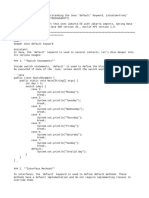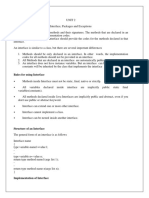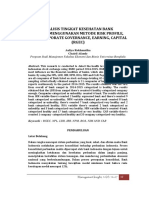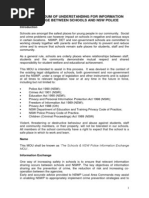Default Methods in Java 8 - Shaikh
Uploaded by
Java DeveloperDefault Methods in Java 8 - Shaikh
Uploaded by
Java Developer**Default Methods in Java 8**
Default methods, also known as defender methods or virtual extension methods, were
introduced in Java 8 to provide a way to add new methods to interfaces without breaking
compatibility with classes that implement those interfaces. This feature was added to address
the challenge of evolving existing interfaces without forcing developers to modify all
implementing classes.
**Key Points about Default Methods:**
1. **Introduction of New Methods:** Default methods allow developers to add new methods to
existing interfaces without requiring changes in the classes that implement those interfaces.
2. **Default Method Implementation:** Default methods provide a default implementation within
the interface itself. This default implementation is inherited by classes that implement the
interface unless the implementing class overrides the default method.
3. **Use Case:** Default methods are particularly useful when you want to add new methods to
an interface in order to introduce new functionality or behavior in a backward-compatible way.
**Example:**
Suppose we have an existing interface `Shape`:
```java
interface Shape {
double area();
void draw();
}
```
We want to introduce a new method `defaultDescription` to provide a default description for
shapes:
```java
interface Shape {
double area();
void draw();
default String defaultDescription() {
return "This is a shape.";
}
}
```
Now, classes that implement the `Shape` interface will inherit the `defaultDescription` method:
```java
class Circle implements Shape {
private double radius;
public Circle(double radius) {
this.radius = radius;
}
@Override
public double area() {
return Math.PI * radius * radius;
}
@Override
public void draw() {
System.out.println("Drawing a circle.");
}
}
public class DefaultMethodExample {
public static void main(String[] args) {
Circle circle = new Circle(5.0);
System.out.println("Area: " + circle.area());
System.out.println("Description: " + circle.defaultDescription());
}
}
```
**Notes:**
- Default methods provide a way to extend existing interfaces without breaking the code that
uses those interfaces.
- In case of conflicts (when a class implements multiple interfaces with default methods of the
same name), the implementing class must provide its own implementation to resolve the
conflict.
- Default methods cannot access private fields or methods of implementing classes.
- Interfaces can also have static methods with implementations in Java 8.
Default methods significantly enhanced the flexibility of Java interfaces by allowing them to
evolve over time while maintaining backward compatibility. This feature is particularly valuable in
library and framework design where interfaces are widely used by various implementations.
You might also like
- Philippine Public Fiscal Administration Leonor Magtolis Briones PDF67% (24)Philippine Public Fiscal Administration Leonor Magtolis Briones PDF1 page
- Java Specific Elements: Course Software Engineering in Electronics and Telecommunications English ClassesNo ratings yetJava Specific Elements: Course Software Engineering in Electronics and Telecommunications English Classes61 pages
- 3-OOP in Java - Version 1.0 - 2016-12-01No ratings yet3-OOP in Java - Version 1.0 - 2016-12-0146 pages
- 22CS202 JAVA PROGG ANSKEY FIAT SIAT ME ESE 2022-2023No ratings yet22CS202 JAVA PROGG ANSKEY FIAT SIAT ME ESE 2022-202333 pages
- Comprehensive OOP Notes For Technical Interview Preparation (Using Java)No ratings yetComprehensive OOP Notes For Technical Interview Preparation (Using Java)26 pages
- Access Determination: Private and Public: A. The PurposeNo ratings yetAccess Determination: Private and Public: A. The Purpose6 pages
- Abstraction in Java With Sample ProgramsNo ratings yetAbstraction in Java With Sample Programs15 pages
- Abstraction in Java: Interfaces Abstract ClassesNo ratings yetAbstraction in Java: Interfaces Abstract Classes11 pages
- Title - Overview of Java 8 Features - ShaikhNo ratings yetTitle - Overview of Java 8 Features - Shaikh2 pages
- Lambdas and Functional Interfaces in Java 8 - ShaikhNo ratings yetLambdas and Functional Interfaces in Java 8 - Shaikh2 pages
- Developer's Guide To Building XML-based Web Services With J2EE (Middleware Company-2001)No ratings yetDeveloper's Guide To Building XML-based Web Services With J2EE (Middleware Company-2001)22 pages
- 8 Multi Threading Enhancementspdf PDF FreeNo ratings yet8 Multi Threading Enhancementspdf PDF Free23 pages
- Magnetic Piston Operated Engine: Sumit Dhangar, Ajinkya Korane, Durgesh BarveNo ratings yetMagnetic Piston Operated Engine: Sumit Dhangar, Ajinkya Korane, Durgesh Barve7 pages
- Fundamentals of Security in Operating SystemsNo ratings yetFundamentals of Security in Operating Systems4 pages
- 03 Wheel Loader Typical Failure Analysis Mannul-AxleNo ratings yet03 Wheel Loader Typical Failure Analysis Mannul-Axle37 pages
- Manila Standard Today - Tuesday (September 25, 2012) IssueNo ratings yetManila Standard Today - Tuesday (September 25, 2012) Issue14 pages
- CSE3009 - PARALLEL-AND-DISTRIBUTED-COMPUTING - LTP - 1.0 - 8 - Parallel and Distributed ComputingNo ratings yetCSE3009 - PARALLEL-AND-DISTRIBUTED-COMPUTING - LTP - 1.0 - 8 - Parallel and Distributed Computing2 pages
- GE Lighting Systems Indoor Lighting Designers Guide 1970100% (1)GE Lighting Systems Indoor Lighting Designers Guide 197056 pages
- Analisis Tingkat Kesehatan Bank Dengan Menggunakan Metode Risk Profile, Good Corporate Governance, Earning, Capital (RGEC)No ratings yetAnalisis Tingkat Kesehatan Bank Dengan Menggunakan Metode Risk Profile, Good Corporate Governance, Earning, Capital (RGEC)16 pages
- Main Relief Valve and Waste Cone - : Submittal DrawingNo ratings yetMain Relief Valve and Waste Cone - : Submittal Drawing2 pages
- Somatic RET Indels in Sporadic Medullary Thyroid CancerNo ratings yetSomatic RET Indels in Sporadic Medullary Thyroid Cancer8 pages































































































